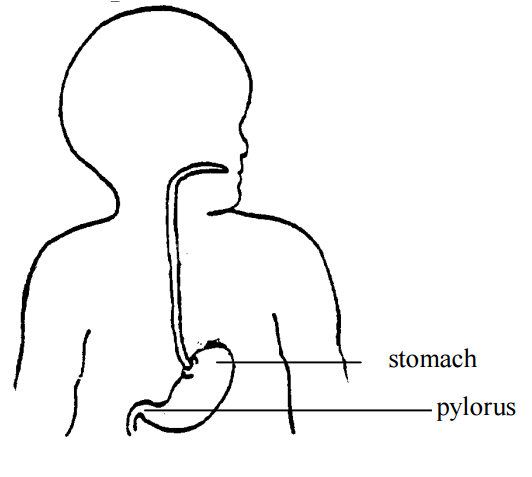Pyloric stenosis
What is pyloric stenosis?
The pylorus (pie-lore-us) is the opening between the stomach and intestines (see picture below). Stenosis means narrowing. Pyloric stenosis means the narrowing of the pylorus, which blocks normal movement of food out of the stomach.

Surgery is needed to open the blockage and allow the stomach to empty. The surgery is called a pyloromyotomy (pie-lore-oh-my-ah-toh-mee).
What are the signs of pyloric stenosis?
The main sign of this condition is vomiting. Usually an infant has been eating well and then begins to vomit forcefully for no apparent reason. The vomiting may get more severe and occur more often.
Pyloric stenosis is diagnosed by the history of vomiting and by the doctor feeling a lump in the upper abdomen during a feeding. The lump is the swollen pylorus. X-rays or ultrasounds are often used to make the diagnosis.
What can I expect before surgery?
Your baby will not be able to eat. Liquids will be given through an IV (small tube in the vein).
What can I expect after surgery?
When your baby is fully awake, feedings are started slowly. It is common for babies to vomit some of the first feedings. When feedings are tolerated, the IV will be stopped.
A monitor may be used to help watch your child for any changes. Pain medicine will be prescribed by the doctor.
You may bathe your baby the day after surgery.
When should I call the surgeon?
- increased swelling, redness, or pain at the incision or the area around it
- drainage from the incision
- temperature higher than 101.5° F rectally
- excessive vomiting
Questions?
This sheet is not specific to your child, but provides general information. If you have any questions, please call the clinic.
Children's Hospitals and Clinics of Minnesota
Patient/Family Education
2525 Chicago Avenue South
Minneapolis, MN 55404
Last reviewed 8/2015 ©Copyright
This page is not specific to your child, but provides general information on the topic above. If you have any questions, please call your clinic. For more reading material about this and other health topics, please call or visit Children's Minnesota Family Resource Center library, or visit www.childrensmn.org/educationmaterials.
© 2024 Children's Minnesota
